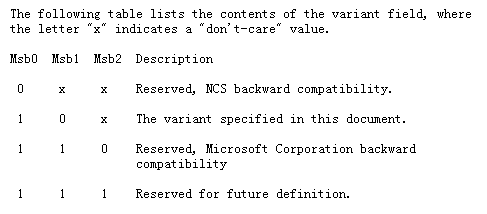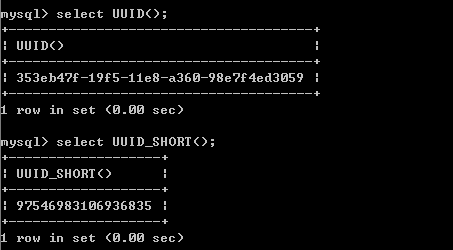UUID简记
一、概述
wiki上的解释:
A universally unique identifier (UUID) is a 128-bit number used to identify information in computer systems.
128位的UUID也并非没有重复的可能,理论证明这个重复的概率很小近乎为零以至于可以忽略。
UUID规范的表示格式通常用32个16进制字符表示(也就是"0" / "1" / "2" / "3" / "4" / "5" / "6" / "7" / "8" / "9" /"a" / "b" / "c" / "d" / "e" / "f"这16个字符)。
这32个字符通常被连字符“-”分成5个组(简记为8-4-4-4-12格式),如下:
8a2986cc-256d-470b-bc3d-027113f76553
5个组所表示的含义如下表所示(图表来自wiki):
| Name | Length (bytes) | Length (hex digits) | Contents |
|---|---|---|---|
| time_low | 4 | 8 | integer giving the low 32 bits of the time |
| time_mid | 2 | 4 | integer giving the middle 16 bits of the time |
| time_hi_and_version | 2 | 4 | 4-bit "version" in the most significant bits, followed by the high 12 bits of the time |
| clock_seq_hi_and_res clock_seq_low | 2 | 4 | 1-3 bit "variant" in the most significant bits, followed by the 13-15 bit clock sequence |
| node | 6 | 12 | the 48-bit node id |
其中version代表了UUID按照何种规则产生。UUID有四种版本:
1、Time-based UUID
2、DCE security UUID
3、Name-based UUID
4、Randomly generated UUID
Version 1 UUIDs are generated from a time and a node id (usually the MAC address); version 2 UUIDs are generated from an identifier (usually a group or user id), time, and a node id; versions 3 and 5 produce deterministic UUIDs generated by hashing a namespace identifier and name; and version 4 UUIDs are generated using a random or pseudo-random number.
variant(变体,或者更通俗的理解就是类型,type)代表了UUID的位布局。UUID也有四种变体,除了variant 位的不同,variant 1和variant 2的区别在于存储和传输时,variant 1用网络字节序(大端模式),variant 2用本地字节序(小端模式)。

二、Java中UUID实现
java中提供了UUID类。在UUID类的内部,将128位分两部分存储:最低有效位(64位)leastSigBits和最高有效位(64位)mostSigBits
其文档中对这两部分的位布局做了简单说明,但是这里好像与wiki上面的有点出入,按照wiki的说法,这里应该是variant 1而不是variant 2,并且在randomUUID()中重置variant位时也是重置了2个bit位:10xx,总之这里关注重点即可。
* <p>The layout of a variant 2 (Leach-Salz) UUID is as follows: * * The most significant long consists of the following unsigned fields: * <pre> * 0xFFFFFFFF00000000 time_low * 0x00000000FFFF0000 time_mid * 0x000000000000F000 version * 0x0000000000000FFF time_hi * </pre> * The least significant long consists of the following unsigned fields: * <pre> * 0xC000000000000000 variant * 0x3FFF000000000000 clock_seq * 0x0000FFFFFFFFFFFF node * </pre>
UUID通过静态工厂方法产生伪随机的UUID,生成UUID实例的步骤大致如下:
1、产生长度为16的伪随机字节数组
2、重置version位和variant位,4bit的version位重置为0100,2bit的variant位重置为10xx。
3、调用私有构造器UUID(byte[] data),将步骤2中的随机字节数组的前8字节给mostSigBits,后8字节给leastSigBits,至此,一个UUID实例产生。
public static UUID randomUUID() { SecureRandom ng = numberGenerator; if (ng == null) { numberGenerator = ng = new SecureRandom(); } byte[] randomBytes = new byte[16]; ng.nextBytes(randomBytes); randomBytes[6] &= 0x0f; /* clear version */ randomBytes[6] |= 0x40; /* set to version 4 */ randomBytes[8] &= 0x3f; /* clear variant */ randomBytes[8] |= 0x80; /* set to IETF variant */ return new UUID(randomBytes); } private UUID(byte[] data) { long msb = 0; long lsb = 0; assert data.length == 16; for (int i=0; i<8; i++) msb = (msb << 8) | (data[i] & 0xff); for (int i=8; i<16; i++) lsb = (lsb << 8) | (data[i] & 0xff); this.mostSigBits = msb; this.leastSigBits = lsb; }
用法如下:
UUID uuid = UUID.randomUUID(); System.out.println(uuid.toString());//f2fbeb3c-07e0-41e2-8dd2-1a49e77d6d67 System.out.println(Long.toHexString(uuid.getMostSignificantBits()));//f2fbeb3c07e041e2 System.out.println(Long.toHexString(uuid.getLeastSignificantBits()));//8dd21a49e77d6d67
也可以产生version 3的UUID,以传入的字节数组name为参数,通过MD5算法生成长度为16的字节数组,之后的处理过程与上面的类似。
public static UUID nameUUIDFromBytes(byte[] name) { MessageDigest md; try { md = MessageDigest.getInstance("MD5"); } catch (NoSuchAlgorithmException nsae) { throw new InternalError("MD5 not supported"); } byte[] md5Bytes = md.digest(name); md5Bytes[6] &= 0x0f; /* clear version */ md5Bytes[6] |= 0x30; /* set to version 3 */ md5Bytes[8] &= 0x3f; /* clear variant */ md5Bytes[8] |= 0x80; /* set to IETF variant */ return new UUID(md5Bytes); }
用法如下:
UUID uuid = UUID.nameUUIDFromBytes("2018".getBytes());
System.out.println(uuid.toString());//84ddfb34-126f-33a4-8ee3-8d7044e87276
三、MySQL中的UUID
MySQL中提供了UUID()函数来获取UUID,必要的情况下可以方便地以此充当表的主键。此外,UUID_SHORT()函数返回一个64位的无符号数字。

四、参考资料
1、https://en.wikipedia.org/wiki/Universally_unique_identifier
2、https://tools.ietf.org/html/rfc4122#section-4.1
3、https://dev.mysql.com/doc/refman/5.5/en/miscellaneous-functions.html#function_uuid
4、JDK1.6 src



